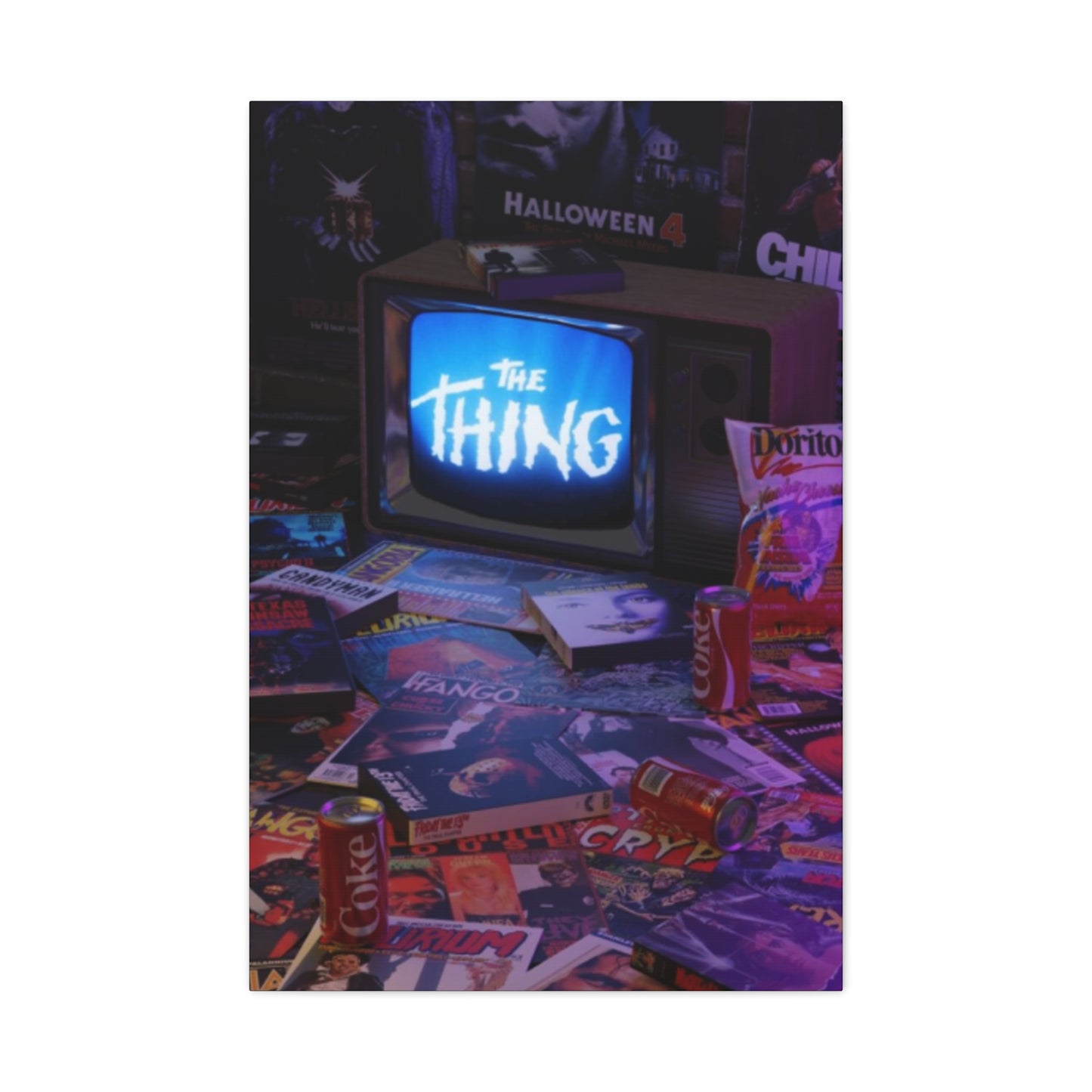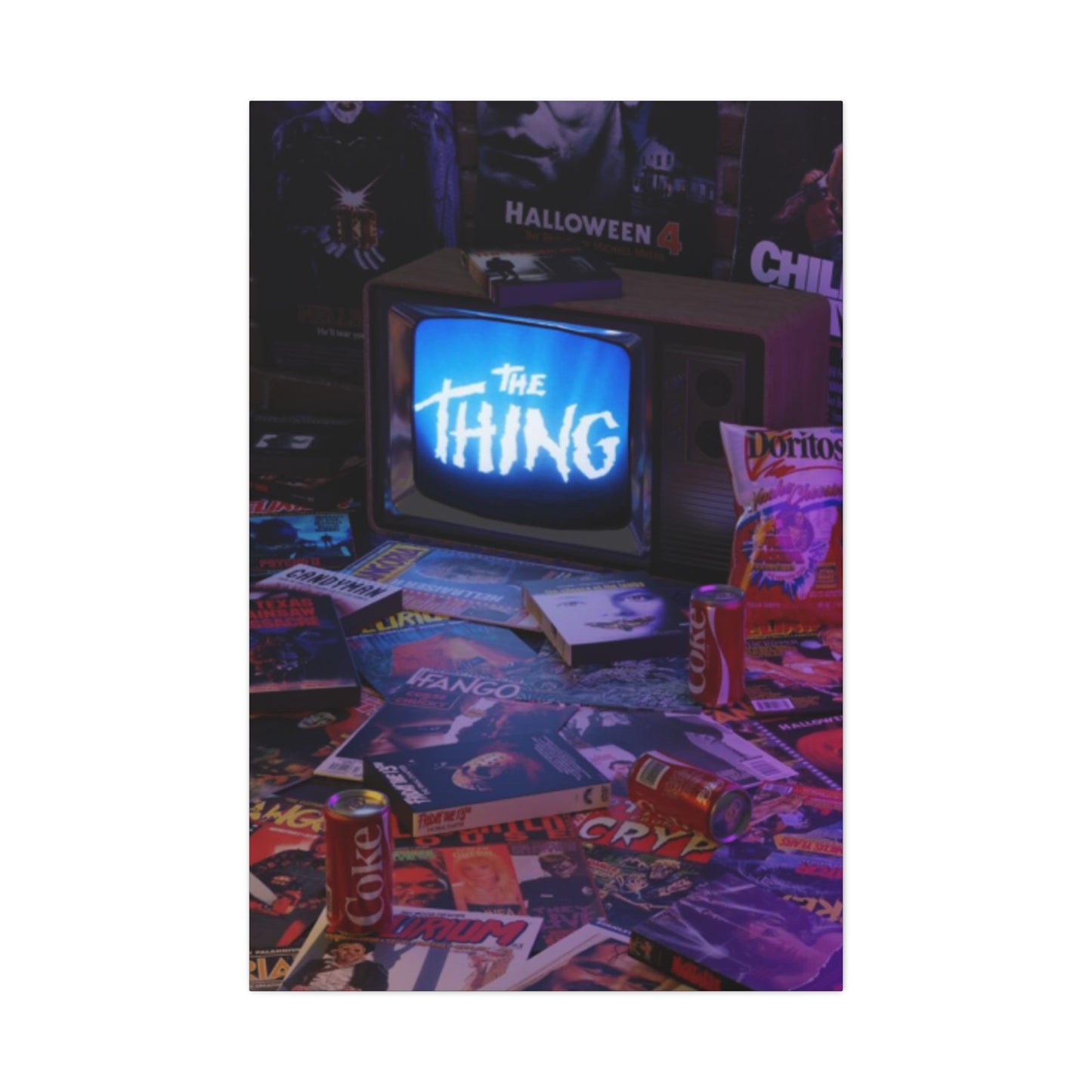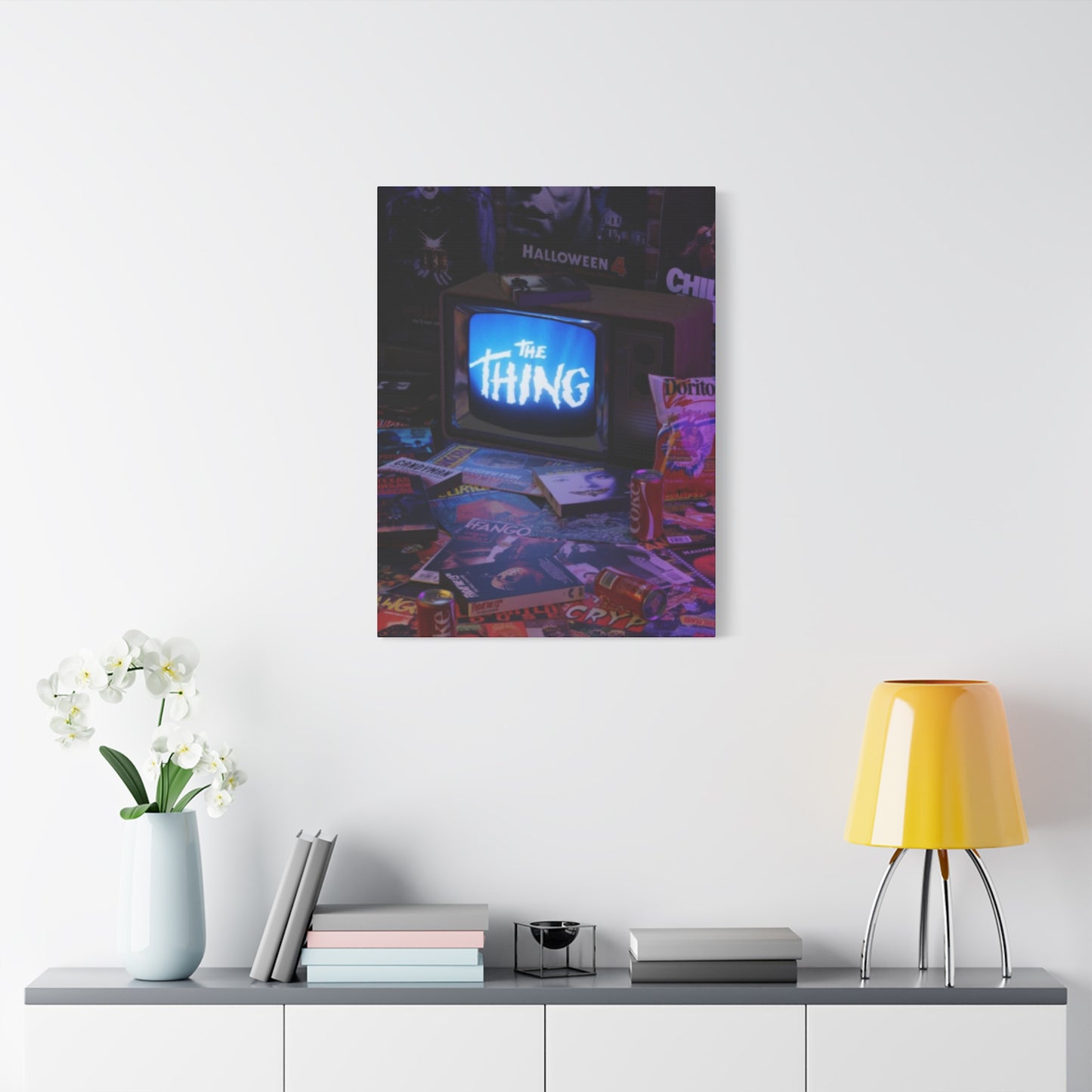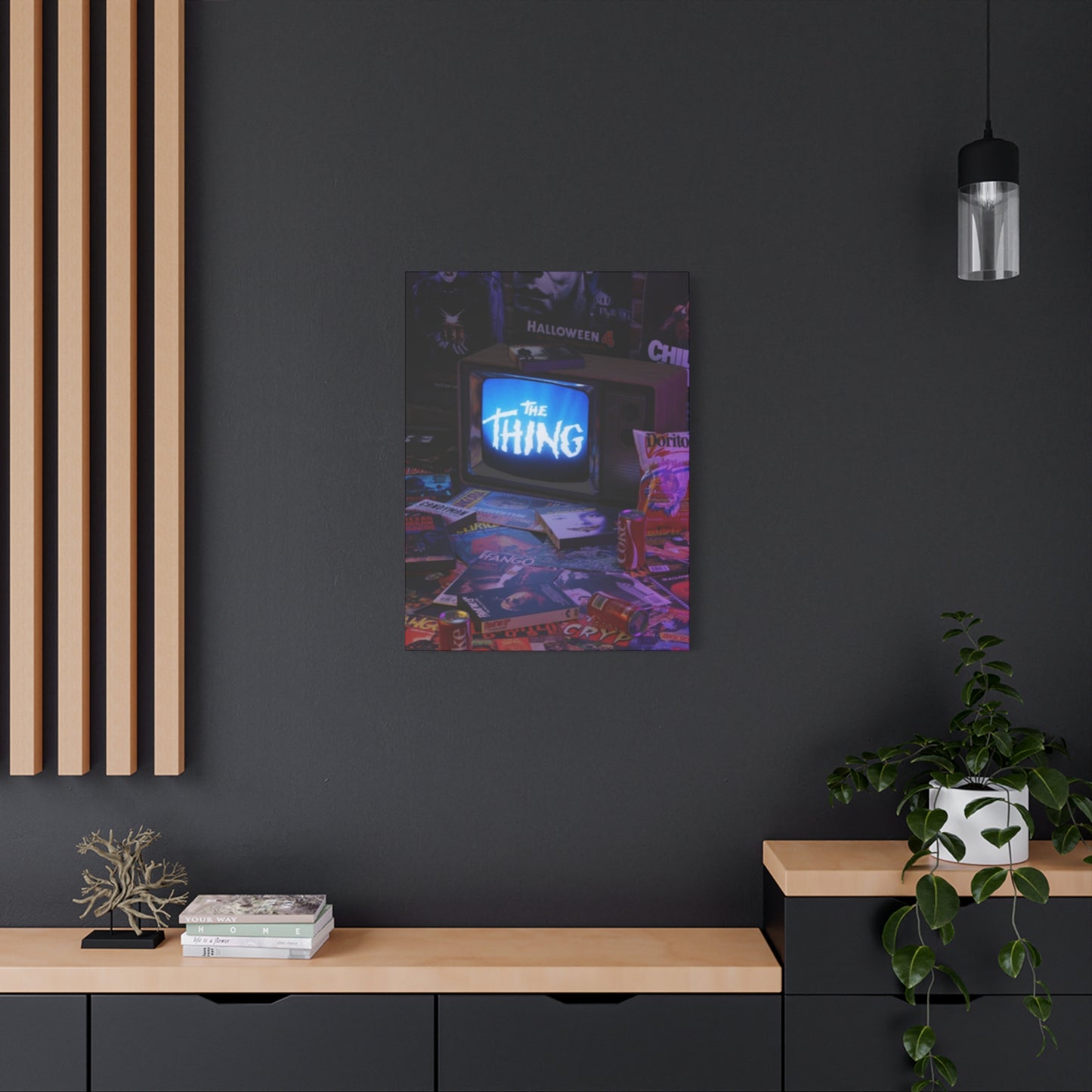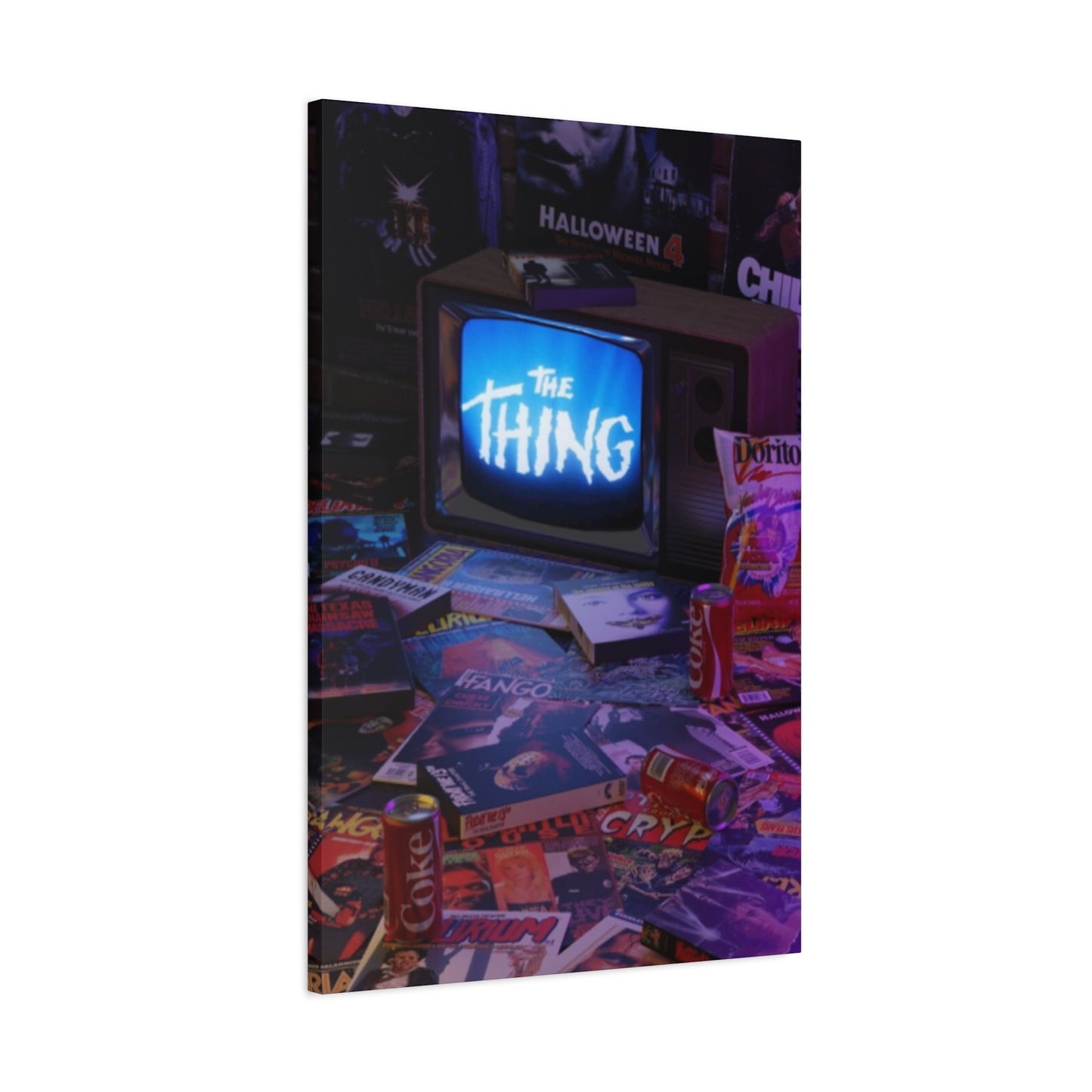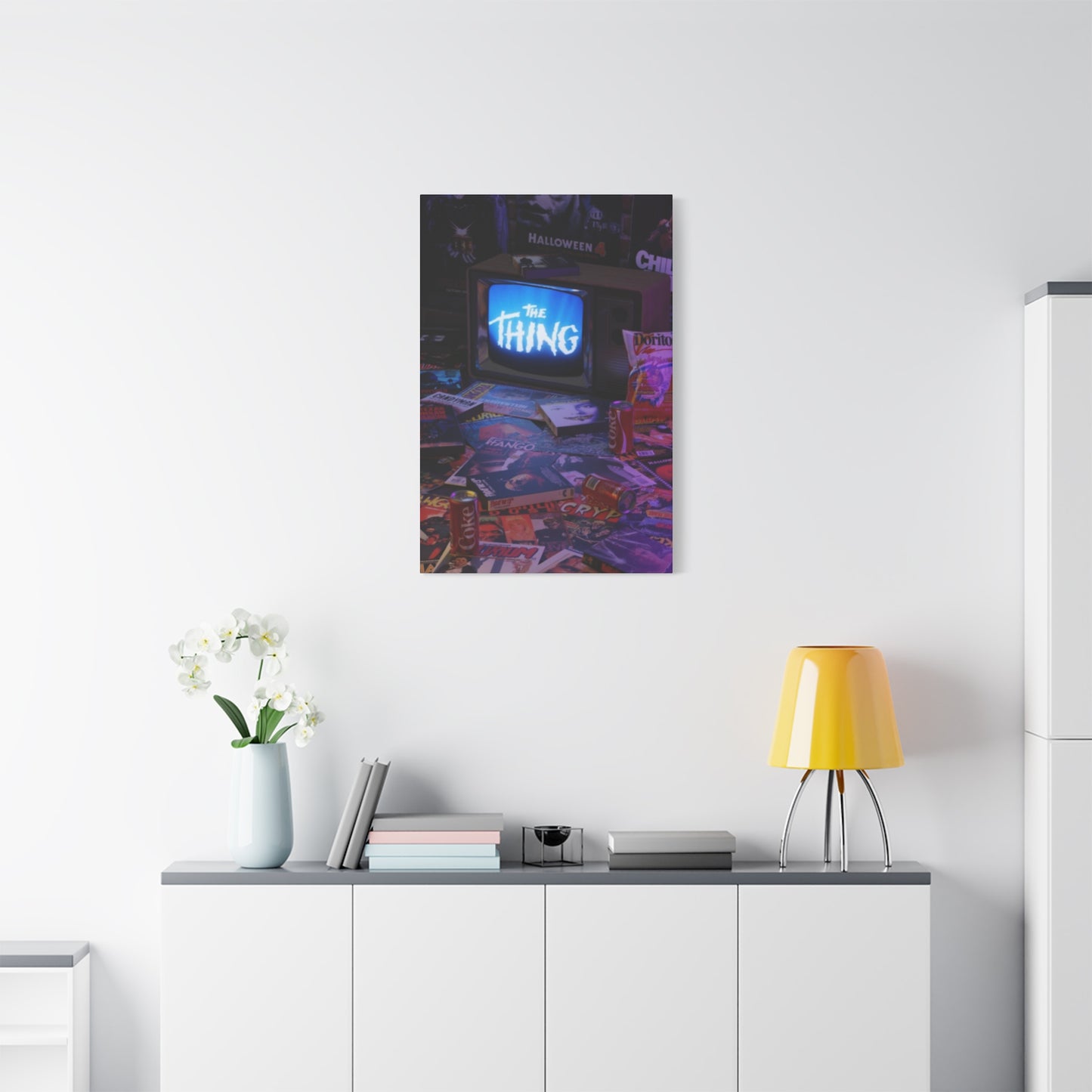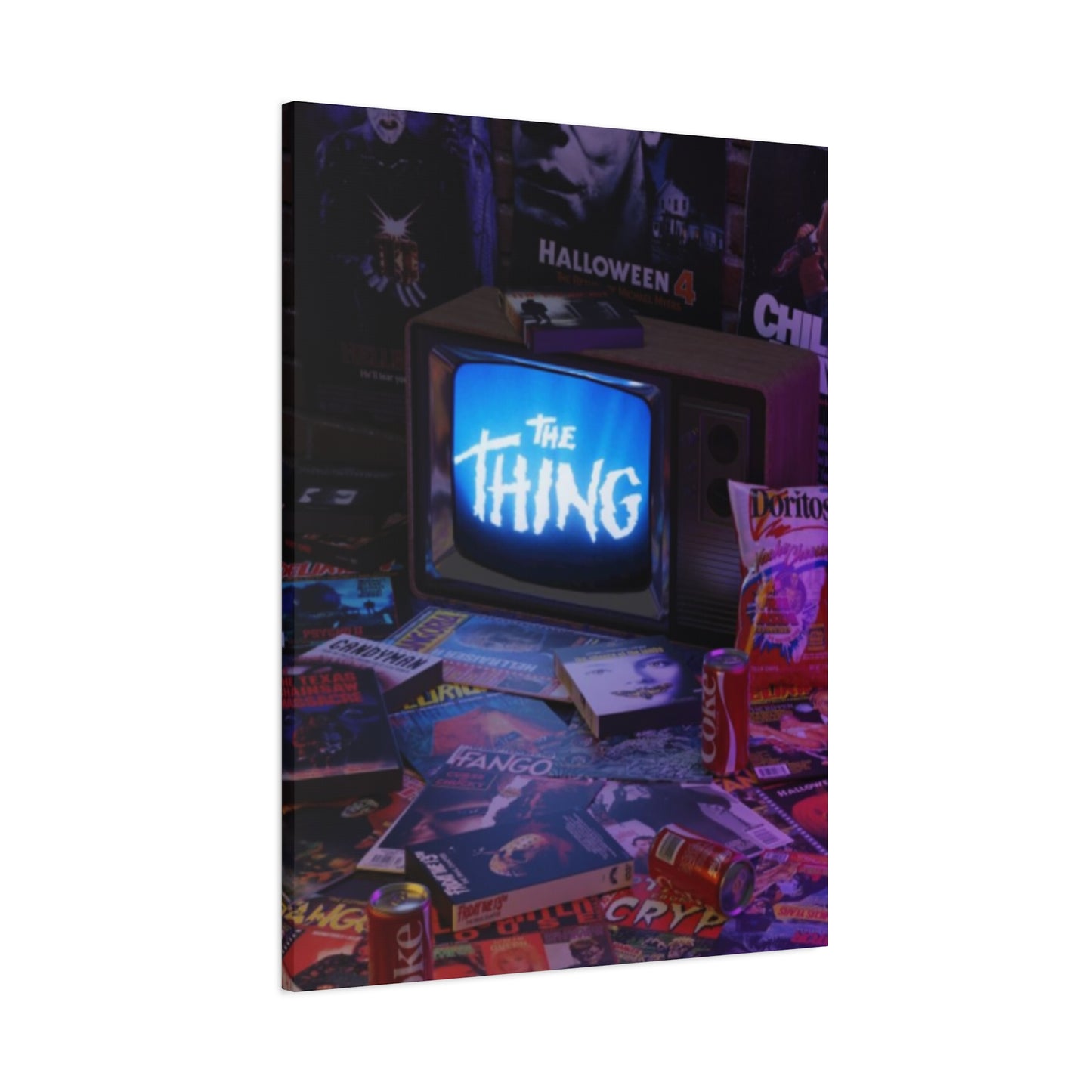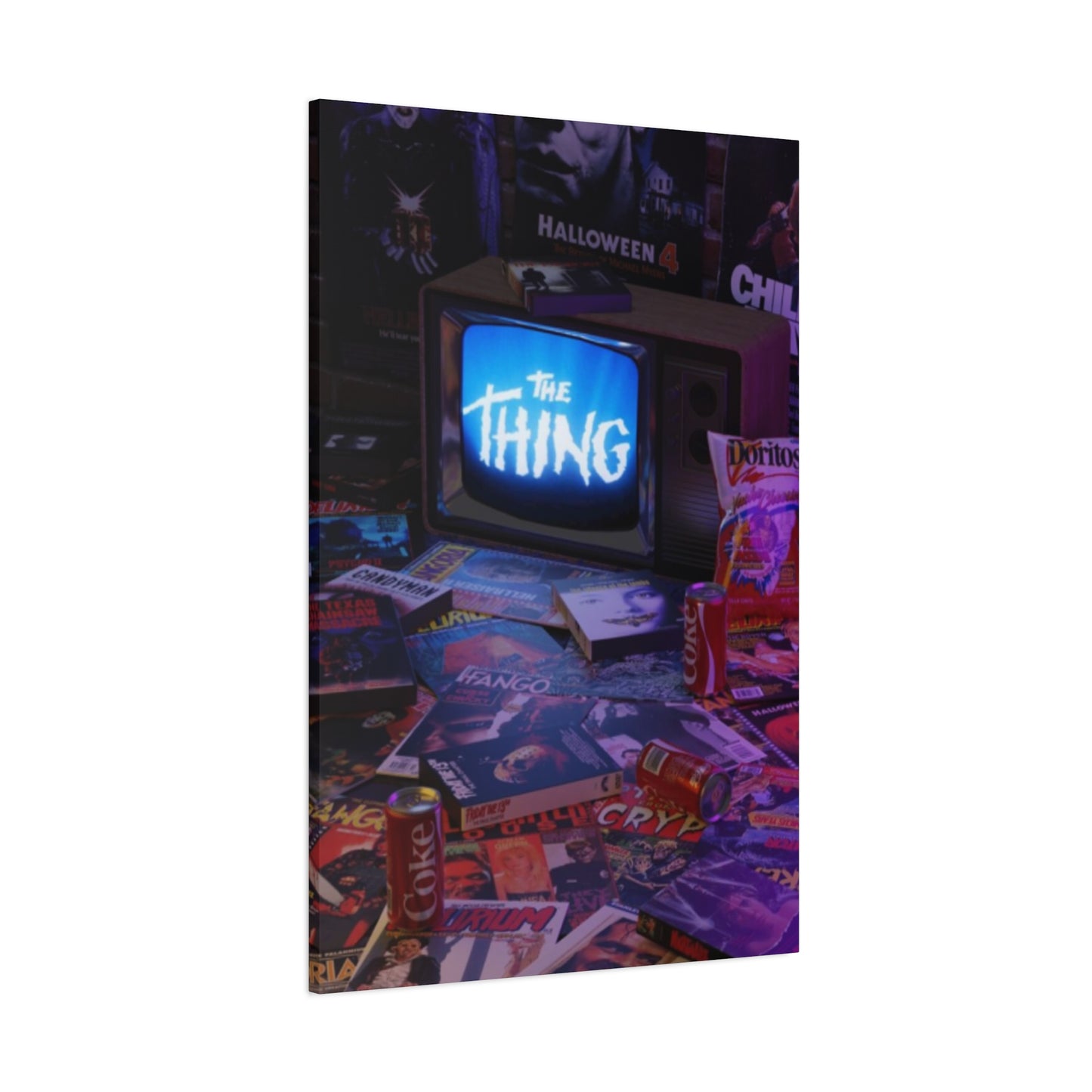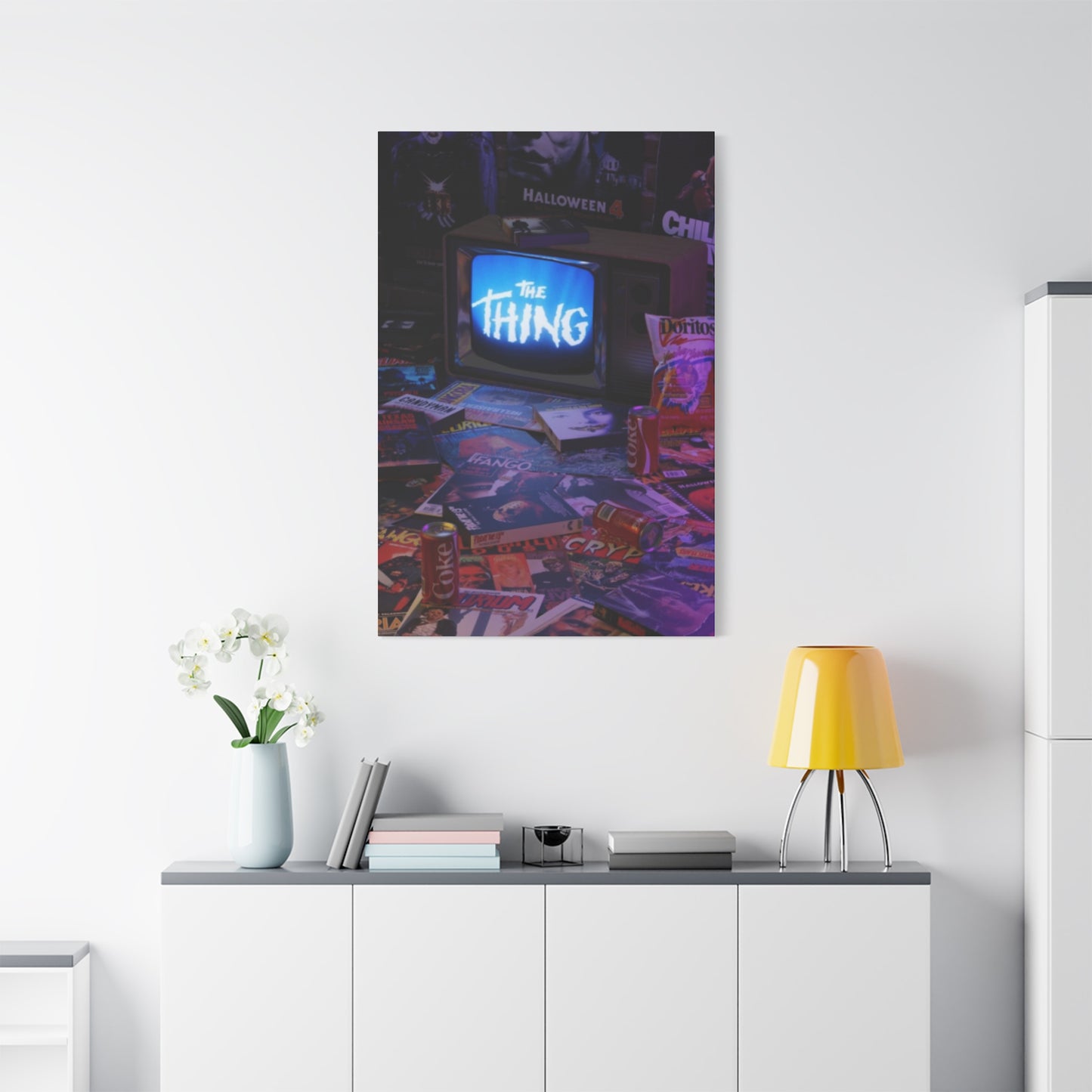Chilling Visions: A Deep Dive into The Thing Horror Movie Poster and Its Enduring Legacy in Wall Art
The world of cinema is filled with iconic imagery, but few pieces of marketing art have captured the spirit of their source material as perfectly and as chillingly as the original key art for John Carpenter's 1982 sci-fi horror masterpiece. The Thing horror movie poster is more than just a promotional tool; it is a piece of cultural shorthand, a window into a story of profound paranoia, isolation, and identity-consuming terror. For collectors, this image, and the many variations it has inspired, represents a pinnacle of the genre. It's not just about owning a piece of paper or a swatch of canvas; it's about capturing a feeling. This journey into the world of collecting The Thing wall art is a journey into the heart of the film itself. It explores how a single, powerful image, created under immense pressure, came to define a film that was initially dismissed, only to be later revered as one of the greatest horror films ever made. From the ethereal glow of the original one-sheet to the gritty, modern interpretations found on limited-edition canvas prints, the art of "The Thing" tells its own story of artistic brilliance, collector passion, and the undying appeal of a perfect monster.
The Enduring Chill of John Carpenter's 1982 Masterpiece
To understand the power of The Thing horror movie poster, one must first appreciate the profound and desolate masterpiece it represents. When John Carpenter’s film was first released, it was met with critical disdain and commercial indifference. It arrived in the summer of 1982, a season dominated by the optimistic glow of Steven Spielberg's E.T. the Extra-Terrestrial. Audiences, it seemed, were in the mood for a friendly alien, not a nihilistic, shape-shifting entity that destroyed its victims from the inside out. Carpenter's film, with its bleak Antarctic setting, all-male cast consumed by suspicion, and groundbreaking, grotesque practical effects, was simply too much for the sensibilities of the time. The film’s themes were dark and resonant of a deeper cultural anxiety. It was a story not about an external threat to be fought, but an internal one that had already infiltrated the group. The paranoia was the real monster, with the creature itself serving as the catalyst. This narrative of broken trust and the horrifying loss of self was a direct reflection of the simmering Cold War anxieties of the era, where the enemy could be anyone, even your neighbor.
It was only years later, through home video and cable television, that the film found its audience and its rightful place in the cinematic pantheon. Viewers began to appreciate its masterful tension, the stark beauty of its desolate landscapes, and the sheer audacity of its practical effects by Rob Bottin. The "blood test" scene remains one of the most perfectly executed sequences of suspense in film history. This slow-burn re-evaluation cemented "The Thing" as a cult classic, and eventually, as an undisputed benchmark of the sci-fi horror genre. This legacy is the fertile ground from which the poster’s own icon-status grew. The artwork is not just for a movie; it is for a film that defied its own failure to become a legend. This gives every piece of related wall art, especially The Thing canvas prints that highlight the art’s texture, a weight and significance that few other films can claim. It represents a vindication of uncompromising vision, making it a badge of honor for horror connoisseurs.
Decoding the Face of Terror: The Drew Struzan The Thing Horror Movie Poster
The story behind the original, legendary The Thing horror movie poster is almost as intense as the film itself. The artist responsible for this iconic image is Drew Struzan, a legend in the poster industry known for his work on franchises like Star Wars and Indiana Jones. However, his creation for "The Thing" was born from sheer necessity and an impossible deadline. The studio was in a rush and needed key art immediately, but the film's revolutionary practical effects were a closely guarded secret. Rob Bottin’s creature designs were not to be revealed in the marketing. This left the promotional team in a difficult position: how do you sell a monster movie without showing the monster? The task fell to Struzan, who was given less than twenty-four hours to conceive of and create the poster. With no monster to paint and no time to even see the film, Struzan was given only the title and the chilling premise.
His solution was a stroke of genius. He decided to capture the feeling of the film rather than a specific scene. As the story goes, he had his wife take a quick Polaroid photograph of him posing in a snow parka with the hood up, his face obscured. Using this simple photo as a reference, Struzan worked through the night, airbrushing and painting to create the ambiguous figure that now defines the film. The figure is anonymous, potentially faceless, representing any member of the crew at Outpost 31. Are they human, or are they the creature imitating a human? The genius is in this ambiguity. The most striking element, however, is the light. An ethereal, blindingly white-blue glow emanates from within the hood and from the title treatment, suggesting an alien, unnatural energy. It’s a cold light, not a warm one, perfectly mirroring the Antarctic setting and the creature's cold, calculated intelligence. The poster is a masterclass in suggestion. It doesn't show you the horror; it shows you a man confronting an unseen horror, or perhaps, becoming it. This minimalist, suggestive approach is precisely why it remains so powerful and timeless, making it one of the most sought-after designs for any The Thing wall art.
The Thing Horror Movie Poster
The world of horror cinema has given audiences countless memorable moments, but few films have left such an indelible mark on popular culture as John Carpenter's masterpiece from 1982. When discussing collectible items that capture the essence of this groundbreaking creature feature, the poster artwork stands as one of the most sought-after pieces among enthusiasts and casual fans alike. These visual representations have transcended their original marketing purpose to become cherished art pieces that adorn the walls of homes, theaters, and galleries worldwide.Horror movie memorabilia represents more than simple decoration. For dedicated collectors and film appreciation enthusiasts, these items serve as tangible connections to cinematic experiences that shaped their understanding of suspense, terror, and storytelling innovation. The poster designs from this particular Antarctic nightmare have become iconic symbols within the horror genre, recognized instantly by fans across generations. The artwork captures the isolated dread and paranoid atmosphere that made the film unforgettable, translating those feelings into visual compositions that continue to resonate decades after the original theatrical release.
Canvas prints have revolutionized how people display their favorite movie artwork. Unlike traditional paper posters that require framing and careful handling, modern canvas printing technology allows fans to showcase these designs with gallery-quality presentation. The texture and depth that canvas provides creates an elevated viewing experience, transforming what might have been a simple poster into a conversation piece that commands attention. These prints capture the shadowy silhouettes, the ominous Antarctic landscapes, and the creature elements that defined the visual identity of this classic film.Collecting movie posters has evolved into a serious hobby that combines passion for cinema with investment potential. Original theatrical posters from significant releases can appreciate substantially in value over time, particularly when they represent films that have achieved cult status or widespread critical recognition. The artwork from this particular alien invasion story has proven especially valuable, with certain original prints commanding impressive prices at auctions and specialty retailers. Even reproduction prints and canvas versions maintain strong market interest, as new generations discover the film and seek ways to celebrate their appreciation.
The Thing" Poster: A Horror Icon
The film poster for John Carpenter’s 1982 masterpiece, The Thing, transcends its original function as mere marketing material to stand as a definitive icon of the horror genre. Designed by the legendary Drew Struzan (though often credited solely for the logo and minor details, the final composition and painting belong to Struzan and others), the primary theatrical poster is a stark, unforgettable image that captures the very essence of the film’s paranoia and existential dread. It is, first and foremost, a portrait of anonymity and isolation. The central figure—a man, possibly Kurt Russell’s MacReady, though intentionally obscured—stands alone against a vast, blinding white backdrop, the desolate, frozen landscape of Antarctica implied by the chilling atmosphere rather than detailed depiction.
The genius of the design lies in what it chooses not to show. In an era where many horror films relied on explicit monster imagery or screaming faces, The Thing presented a mystery. The figure’s face is completely shadowed beneath the brim of a wide-brimmed hat, the only source of light emanating from the mysterious glow of an unseen structure beneath his coat collar. This single, unsettling detail immediately communicates that the threat is internal, insidious, and hidden. It is a visual representation of the core narrative—the impossibility of knowing who is human and who is an alien imitation. The poster's power is derived from its ability to evoke anxiety not through gore, but through radical uncertainty.
Furthermore, the design’s minimalist composition achieves maximum emotional impact. The deep, inky blacks of the man’s silhouette contrast violently with the sterile, almost sickly white background, creating a visual duality of darkness and exposure. This high-contrast palette screams urgency and severity. The iconic tagline, “Man is The Warmest Place to Hide,” often accompanying the image, acts as the final, perfectly calibrated piece of psychological warfare. It transforms the image from a simple picture into a horrifying philosophical statement, confirming the internal nature of the terror and cementing the poster's legacy. Unlike fleeting promotional materials, this image has endured, continuously reproduced and revered, precisely because it is less a depiction of a movie and more a monument to primal fear itself. It is, undeniably, the visual shorthand for a generation of body horror and psychological terror.
How "The Thing" Influenced Horror Posters
Drew Struzan’s 1982 poster for John Carpenter’s “The Thing” marked a significant departure from the prevailing trends in 1980s horror movie advertising, influencing subsequent poster design by emphasizing minimalism, atmosphere, and psychological dread over explicit gore or monster reveals. While the decade was largely defined by gruesome imagery, masked killers, and often busy compositions common in the slasher genre, "The Thing" poster presented a stark, enigmatic figure—a lone person in a parka, their face obscured by a blinding white and blue light. This choice immediately set it apart.The poster’s focus is not on what the monster looks like, but on the chilling idea of it.
By concealing the alien's true form and even the human host’s identity, the artwork perfectly captured the film's core theme of paranoia and loss of identity. This strategy of suggestion over depiction encouraged a more intellectual and atmospheric form of horror on the movie one-sheet. It forced the audience to project their own fears and the film’s central question—Who can you trust?—onto the image. This technique of suggestive horror and using a lone, dramatically lit figure in a vast, cold environment has since become an influential visual shorthand for films dealing with isolation, shapeshifting threats, or existential terror. It proved that a poster could be both highly artistic and profoundly disturbing without relying on cheap scares, pushing the boundaries of what horror art could be.
Minimalism in "The Thing" Poster Design
The effectiveness of Drew Struzan's poster for “The Thing” is a masterclass in cinematic minimalism, a design choice that defied the era's maximalist tendencies. Created under extreme time pressure and with little information about the film, the artist was forced to think abstractly. He centered the design on a single, isolated figure clad in a heavy winter parka, its face completely obscured by a brilliant, otherworldly light emanating from within the hood.This simple, powerful composition uses only a few key elements: the stark silhouette of the human form, the deep, icy blues of the Antarctic setting, and the explosive, alien white light.
The figure's ambiguous posture and the total obfuscation of its face instantly convey the film's central mystery—identity and assimilation. The minimalism allows the audience's mind to fill the terrifying void; the lack of a recognizable face means anyone could be the 'Thing'. The icy texture and deep color palette reinforce the film's atmosphere of extreme isolation and cold dread. Unlike many contemporary posters that crammed in multiple character portraits or scenes of violence, Struzan’s design is bold, abstract, and symbolic, elevating the poster from mere movie advertisement to a piece of evocative, defining genre art. This clean, symbolic approach ensured its timeless quality and lasting visual impact.
Color and Symbolism in "The Thing" Poster
The color and symbolism in the poster for “The Thing” are crucial to its enduring psychological power. The dominant hues are stark blues and white, immediately establishing the remote, frozen, and unforgiving Antarctic setting, a place of extreme isolation and vulnerability. The use of deep, chilling blue tones conveys a pervasive sense of coldness and foreboding. These colors visually echo the claustrophobic and hopeless atmosphere of the film, where the characters are cut off from the world and preyed upon by an unseen enemy.The most symbolically potent element is the blinding white and yellow light emanating from beneath the figure’s hooded parka, completely obscuring the face.
This light serves multiple symbolic functions. Firstly, it represents the alien entity itself—a force of pure, mysterious, and unknowable terror. Since the Thing has no single true form, this abstract light is the perfect visual representation of an unclassifiable threat. Secondly, the hidden face is a metaphor for the film’s central theme of paranoia and the betrayal of trust. The light literally makes the figure faceless, signifying the loss of human identity and the terrifying notion that a friend or colleague could be an assimilated imposter. The light bursts through the human guise, symbolizing the alien presence violently attempting to break out, a promise of the practical body horror within the film.
Poster is a Collector’s Gem
The original 1982 one-sheet poster for “The Thing” is widely regarded as a significant collector’s gem, commanding high prices in the movie art market for several key reasons beyond its aesthetic brilliance. Firstly, it is the work of legendary illustrator Drew Struzan, whose posters for Star Wars, Indiana Jones, and Back to the Future define the golden age of hand-painted movie art. This pedigree alone grants it enormous value.Secondly, the poster is a piece of cinematic history tied to a film that was a critical and commercial failure upon its initial release, only to be rediscovered and hailed as a classic years later.
Because the film flopped, fewer posters were likely printed and saved compared to blockbusters like E.T. (which opened the same week), making original, rolled copies genuinely rare. Its initial connection to a box-office bomb ironically contributes to its present-day scarcity and collectibility. Finally, the poster's artistic merit—its distinctive minimalism, enigmatic symbolism, and departure from contemporary horror tropes—makes it a landmark in horror art, a visually unique and powerful image that transcends its promotional purpose. Its status as an iconic image of the horror genre, combined with its rarity and the artist's legacy, solidifies its position as a highly sought-after collector's item.
Horror Posters: The Art of Fear on Your Walls
Horror movie posters have long been more than just marketing tools—they are visual statements that capture the essence of terror and intrigue. With their bold imagery and unsettling designs, they serve as a window into the world of fear, offering a glimpse of the chilling experiences that await in the films they promote. Whether you're a dedicated horror fan or someone simply looking to add a unique touch to your home décor, horror movie posters are a fantastic way to bring the art of fear into your living space.One of the key reasons horror posters stand out is their ability to evoke emotion through visual storytelling. A well-designed poster doesn’t just hint at the movie's plot; it communicates the atmosphere, the tone, and the primal fears at play. Take The Exorcist poster, for example. Its minimalist design, featuring just a haunting image of a child’s silhouette and a stark black background, immediately evokes a sense of unease.
This simplicity mirrors the film’s raw horror, where terror is often more psychological than physical.Moreover, horror posters are often highly stylized, incorporating elements of surrealism, expressionism, and grotesque artistry. The use of contrasting colors, distorted imagery, and disturbing visuals can elevate the poster to something that feels like art rather than just advertising. This makes them incredibly captivating, not just for horror buffs, but also for art lovers who appreciate the craft of creating fear through visual means.The vintage charm of classic horror posters adds another layer of appeal. Posters from the 70s and 80s, like those for Nightmare on Elm Street or The Texas Chainsaw Massacre, often had a tactile, gritty quality—almost as if they themselves had survived the horrors they depicted.
These posters didn’t shy away from bold typography, vibrant colors, and images that bordered on the surreal, creating a visual experience that was as unnerving as the films themselves.In the modern era, horror posters continue to evolve, blending contemporary design trends with timeless motifs. Movie posters for films like Hereditary or Get Out showcase clean lines, minimalist design, and clever use of symbolism. These modern takes on horror poster art still carry the same unsettling energy but adapt to today’s more subtle, psychological approach to fear.For anyone looking to add a unique, conversation-starting piece to their home, horror movie posters are an excellent choice. They combine the thrill of cinema with the power of visual art, turning your walls into a gallery of fear. Whether it's the classic scream of a slasher film or the eerie stillness of supernatural terror, horror posters are a bold way to make a statement in your home while celebrating one of the most dynamic genres in film history.
Horror Movie Posters Are Perfect for Home Décor
Horror movie posters have carved out a niche as a unique form of wall art, seamlessly blending style, emotion, and cinematic history into a decorative statement piece. What makes them so perfect for home décor is their ability to elicit powerful emotions while offering a distinctive visual element that can either stand out boldly or subtly enhance a room's atmosphere. From chilling imagery to the thrill of iconic movie moments, horror posters are not only for genre fans—they are for anyone who wants to infuse their space with personality and mood.The first reason horror movie posters work so well in home décor is their ability to convey a strong sense of atmosphere. Horror films often rely on visuals to establish their tone, whether it’s the dark, oppressive feel of a supernatural thriller or the high-octane terror of a slasher film. A poster from
The Shining, with its isolated hotel corridors and icy, forbidding imagery, can evoke a mood of suspense and tension, perfect for a living room or even a hallway. Similarly, the abstract yet captivating design of The Babadook can contribute an eerie undercurrent to a room, sparking conversation and setting a distinctive tone without overwhelming the space.Horror posters also offer a variety of design styles that fit different tastes. Classic posters from the 70s and 80s often used exaggerated typography, bold colors, and highly stylized imagery, which can fit well into retro or eclectic spaces. The vibrant, high-energy designs of movies like Evil Dead or Friday the 13th can bring a punch of color and intensity to a room. These posters add life to spaces that might need a pop of color or a conversation starter, all while maintaining a sense of intrigue and excitement.
On the other hand, more minimalist and contemporary horror posters can bring a sense of sophistication while still maintaining an eerie edge. Films like The Witch or A Quiet Place often use subtle designs and muted color palettes that work beautifully in modern, minimalist interiors. The psychological horror aspect is reflected in the restrained yet unnerving visuals, allowing them to blend seamlessly into modern décor without sacrificing impact. These posters allow fans of the genre to express their taste for horror while adhering to the stylistic trends of today's home design.Beyond the visual appeal, horror movie posters are an excellent way to add personality to a room. They tell stories and reflect the passions and interests of the homeowner. For fans of the genre, displaying a carefully chosen poster can be a proud declaration of their love for horror. For others, these posters might be a conversation starter, sparking discussions about the psychological intricacies of films, their artistry, or the cultural significance of fear in cinema.
Horror posters also make a great addition to home offices, theaters, or entertainment spaces. In these environments, the chilling imagery of horror films can add to the fun, adding a quirky, unexpected twist to an otherwise practical space. Imagine watching a movie in a home theater with walls lined with iconic horror posters—there’s a built-in connection between the space and the films that makes the experience even more immersive.Overall, horror movie posters are more than just images on a wall—they are a reflection of style, taste, and the power of fear in visual art. Whether bold and retro or subtle and modern, horror posters offer a unique and striking way to enhance your living space with an edge that’s both captivating and memorable.
Creepy or Cool? Horror Posters as Wall Art
Horror movie posters have long been the subject of debate when it comes to their role as wall art: are they creepy or cool? The answer is often both. For many, the eerie imagery and disturbing subject matter of these posters are a major draw, adding a layer of suspense or thrill to their living spaces. For others, the bold, often over-the-top designs are seen as a form of kitschy, vintage coolness that speaks to their love of genre films and the macabre. Regardless of how you view them, horror movie posters are undeniably captivating and offer a unique way to decorate your home.One of the key reasons horror posters stand out is their ability to provoke an emotional reaction. Whether it’s the intense dread evoked by a ghostly figure or the grotesque, stylized depictions of violence and monsters, these posters push the boundaries of art in a way that few other genres do. Take Psycho, for example. The poster’s stark, minimalist design—featuring a close-up of Janet Leigh’s terrified face against a sharp black-and-white color scheme—captures the raw terror of Alfred Hitchcock’s film. It’s a striking, unsettling image that commands attention, yet at the same time, it’s undeniably a piece of cinematic history, making it cool in its own right.
On the flip side, the bold, colorful, and often exaggerated styles of vintage horror movie posters from the 70s and 80s are a major draw for collectors and design enthusiasts. Posters for films like The Texas Chainsaw Massacre or Jaws used dramatic typography, eye-catching colors, and action-packed imagery to sell the terror within. These posters are often considered iconic, not just for their horror elements but for their graphic design. Their unique visual language is now appreciated for its retro appeal, making them "cool" pieces of art that can enhance any room with a sense of vintage flair. These posters bring a sense of nostalgia and fun, transforming what could be perceived as creepy into something playful and collectible.Moreover, horror posters are often a great conversation starter. Guests who walk into a room adorned with posters from Nightmare on Elm Street or The Thing may be intrigued or unnerved, depending on their familiarity with the genre. The posters spark curiosity, especially when placed in unexpected places like a hallway or an entryway, where they can serve as an engaging and slightly unsettling introduction to the home. It’s the type of wall art that leaves a lasting impression, making people pause and look closer, much like the films themselves.
Horror posters can also carry an element of irony. Many modern designs for films like It Follows or Hereditary use minimalist techniques that strip away the excess while still retaining their unsettling presence. These contemporary posters look less like classic "horror" art and more like high-end, chic designs. The subtle terror they evoke is far removed from the cheesy aesthetics of old-school horror movie posters, allowing them to blend seamlessly into modern living rooms, offices, or bedrooms. The cool factor here is that they manage to make a sinister impression without screaming "horror"—a perfect balance for anyone who wants to add a touch of fear without overwhelming their space.In the end, whether you find them creepy or cool, horror posters are undeniably compelling pieces of art. They balance the grotesque and the beautiful, often using stark contrast, vibrant colors, and striking visuals to leave a lasting impression on anyone who sees them. By placing them on your walls, you invite a piece of cinematic history into your home—one that speaks to your love of horror, art, and the unique ways fear can be transformed into something visually powerful and, yes, cool.
Turning Your Space into a Horror Haven with Posters
For those who adore the thrills and chills of the horror genre, there's no better way to celebrate your love for the macabre than by transforming your home into a "Horror Haven" with movie posters. These posters are not just visual decorations; they can completely alter the mood and atmosphere of a space, creating an environment that’s both creepy and captivating. Whether you want to embrace your inner horror aficionado or simply add a touch of eerie charm to your décor, horror movie posters offer an easy and effective way to make your space a terrifying masterpiece.The beauty of using horror posters to create a themed space is their versatility. You don’t have to go overboard with a full-on haunted house aesthetic to make an impact. A well-placed Psycho poster in the entryway, a Nightmare on Elm Street print above your bed, or a The Shining poster in the hallway can all add to the ambiance, setting the stage for your very own horror-inspired home. Each poster serves as a reminder of the gripping, edge-of-your-seat moments that you loved about these films, while also adding character and conversation to your space.
One of the most effective ways to curate a horror-themed environment is by grouping posters based on specific subgenres or time periods. For example, you could create a “slasher zone” in your living room with posters from films like Halloween, Friday the 13th, and Scream. These posters would pair well together, creating a high-energy vibe that’s perfect for a movie marathon night. Or, if you prefer a more psychological, slow-burn approach to horror, a collection of posters from films like The Witch, Hereditary, and The Babadook can give your space a more haunting, cerebral atmosphere.For an added layer of atmosphere, consider playing with frames and mounting options. Instead of traditional frames, opt for distressed wood or black metal frames to give your posters a rugged, raw appearance. Alternatively, you could experiment with hanging them in unconventional ways, such as using vintage chains, large pins, or even mounting them directly onto the wall without frames for a grittier, DIY feel. The possibilities are endless, and part of the fun of creating your horror haven lies in how you arrange and display the posters to fit your space and mood.
Lighting also plays a crucial role in enhancing the horror aesthetic. Consider installing dim lighting or using spotlights to highlight certain posters. Subdued, moody lighting will make the artwork stand out without overwhelming the space, allowing the poster’s creepy images to take center stage. For an extra touch, blacklights can be used to make certain colors pop, especially in vintage horror posters from the 70s and 80s that feature bright reds, yellows, and oranges.In addition to the posters themselves, you can further enhance the horror vibe by pairing them with other elements of horror-themed décor. Think skulls, vintage horror VHS tapes, creepy dolls, or antique furniture that looks like it belongs in a haunted mansion. For instance, a The Texas Chainsaw Massacre poster next to a weathered armchair or a Jaws print in the dining room near a nautical-inspired table can create a scene that’s both chilling and visually intriguing.
Perhaps the most exciting aspect of turning your space into a horror haven with posters is the opportunity to express your personal connection to the genre. Whether you’re a fan of classic slashers, supernatural thrillers, or psychological horror, each poster can represent your unique tastes. It’s an aesthetic that’s deeply personal, as it invites the viewer to step into a world where fear is celebrated, not shied away from.In the end, horror movie posters are a perfect way to infuse your space with a sense of dark energy, nostalgia, and creativity. They offer an immediate way to bring your love for the genre into your home, creating an environment that’s sure to thrill both you and your guests. With a mix of iconic imagery, atmospheric lighting, and creative framing, you can turn any room into a true Horror Haven.
The Dark Art of Horror Movie Posters
Horror movie posters are not just promotional tools; they are pieces of art that play a crucial role in shaping the cultural impact of the films they represent. The art of designing horror movie posters lies in creating an image that can evoke fear, suspense, and curiosity—all in one glance. From grotesque monsters to haunting landscapes, the dark art of horror posters takes bold creativity to turn terror into visual storytelling. These posters are more than just advertisements; they are works of art that encapsulate the soul of the film, making them a captivating and chilling addition to any space.
One of the most striking elements of horror movie posters is their ability to use graphic design to immediately convey the mood and atmosphere of the film. Unlike other genres that may rely on bright colors or uplifting images, horror posters often use dark, moody palettes, heavy contrasts, and disturbing imagery. This visual language allows the poster to act as a preview, not just of the plot, but of the emotional experience the viewer can expect. Take The Silence of the Lambs, for example. The stark, yellow background with the iconic image of a moth covering a woman’s mouth isn’t just eerie—it’s deeply symbolic. The image represents the horror and silence at the heart of the film, making it instantly recognizable and deeply unsettling.
Another aspect that makes horror movie posters a form of "dark art" is their use of symbolism and visual metaphors. Often, these posters feature images that play with the subconscious fears of the viewer. A poster for Jaws isn’t just a giant shark; it’s an invitation to the primal fear of the unknown, lurking beneath the surface. Rosemary’s Baby, with its dark, ominous shadow looming over a pregnant woman, uses the human form to communicate the deeply unsettling fear of loss of control and personal violation. These posters are more than just visual representations—they tap into universal fears, whether it’s fear of the supernatural, fear of the unknown, or fear of human violence.
The composition of horror posters is also key to their artistic impact. The use of asymmetry, tension in design, and distorted images reflects the chaos and imbalance that horror films often explore. Take the poster for The Thing, where the alien creature's contorted, glowing visage is framed against a dark, icy backdrop. The disorienting design conveys the film’s themes of isolation, paranoia, and monstrous transformation. The composition makes the viewer feel unsettled, hinting at the horror that lies within, all before the film even starts.
One of the most powerful tools in the dark art of horror movie posters is the use of typography. Horror posters often feature bold, aggressive fonts that scream terror, or, in some cases, minimalist lettering that adds to the sense of isolation and dread. Classic posters like Friday the 13th and Halloween use large, impactful fonts that become synonymous with the films themselves. These bold designs are often accompanied by graphic elements that reinforce the poster's tone—bloody knives, creepy silhouettes, or ominous shadows. Typography is a way of integrating the visual elements of the film into the overall aesthetic of the poster, creating a cohesive and memorable design.
From Classic to Modern: Horror Posters for Every Room
Horror movie posters have evolved dramatically over the years, and this progression from classic to modern designs makes them versatile pieces of art that can fit into any home. Whether you're drawn to the nostalgic charm of retro posters or the sleek, minimalist designs of contemporary ones, horror movie posters can be tailored to suit any room in your house, offering a personalized touch to your décor. The beauty of this genre lies in its ability to span across time, making it possible to curate a collection of posters that reflects your own taste—whether it’s vintage, modern, or somewhere in between.
Classic Horror Posters: Nostalgia Meets Iconic Design
Classic horror posters, especially those from the 1960s through the 1980s, often boast bold, dynamic artwork and high-energy visuals. These posters were designed with an immediacy in mind—everything from the typography to the imagery screamed for attention in dark movie theaters. The Texas Chainsaw Massacre, Halloween, and The Shining feature vibrant colors, exaggerated design elements, and sometimes disturbing images that quickly conveyed the intensity of the film. These posters also carry with them a sense of nostalgia, capturing the essence of a bygone era in cinema.These retro posters are perfect for living rooms, home theaters, or even dedicated horror movie corners, as they add a certain timeless energy. Their bold, graphic nature pairs beautifully with rooms that embrace vintage or eclectic décor.
They can even serve as a conversation piece, especially when displayed alongside other pop-culture memorabilia or mid-century furniture. The design aesthetics of these posters offer a chance to blend horror with classic or vintage styles, bringing a unique twist to the room’s overall vibe.The vibrancy and exaggerated elements of classic horror posters also allow them to become the focal point of a room. A large Nightmare on Elm Street poster, for example, with its vivid reds and sharp, dynamic lines, can dominate a space, serving as the centerpiece of a living area or hallway. The striking visuals from these older films carry a sense of history, evoking the time when horror films were first captivating audiences worldwide.
Modern Horror Posters: Minimalist and Subtle Horror
In contrast to the bold designs of classic horror posters, modern horror posters have shifted toward a more minimalist, nuanced aesthetic. Contemporary horror films like Hereditary, It Follows, and The Witch often feature clean lines, restrained color schemes, and subtle imagery that emphasize psychological terror rather than overt gore. These posters might focus on symbolic imagery—such as the oppressive woods in The Witch or the eerie simplicity of A Quiet Place—that speaks to a more cerebral type of horror.Modern horror posters work particularly well in minimalist or contemporary spaces. They can blend effortlessly into living rooms, bedrooms, or home offices, adding a sophisticated edge to a space without overwhelming it. Because these designs are often more subtle, they’re perfect for those who want to incorporate horror into their décor without creating an overwhelmingly “spooky” atmosphere.
The restrained nature of these posters allows them to blend seamlessly with neutral-colored walls, modern furniture, or Scandinavian-style interiors.In fact, many modern horror posters use muted colors or even black-and-white schemes to evoke dread in more understated ways. A Get Out poster, for example, with its stark black background and subtle, almost abstract figure of the protagonist’s face, conveys the sense of tension and unease without overtly calling attention to itself. This is ideal for spaces where you want the poster to be noticed, but not to dominate the room. The posters work almost like art pieces—evoking a psychological undercurrent that adds depth to the room.
Blending Both: A Horror Collection Across Time
What’s fantastic about horror posters, especially in the home, is that they can span generations of design. For those who love both vintage and modern aesthetics, blending classic and contemporary posters creates an exciting contrast in the room. A wall adorned with posters from films like The Exorcist, The Thing, Hereditary, and Midsommar can offer a stunning visual journey through the evolution of horror design.This fusion of classic and modern can work well in spaces like home theaters, basement lounges, or even corridors where horror lovers can showcase their collection. You could even create an entire room dedicated to horror movie posters, starting with iconic vintage designs and transitioning to newer works that reflect the genre’s transformation.
The posters will bring together different styles of design while maintaining the same core thematic focus on fear, tension, and suspense.Horror posters also adapt well to themed rooms, such as a library or a game room. They can create an immersive experience, where the room becomes a sanctuary for fans of the genre, a place where classic horror films are celebrated alongside modern psychological thrillers. For example, in a game room, vintage posters for Friday the 13th could pair with minimalist posters of films like The Babadook, creating a dynamic juxtaposition that adds intrigue and atmosphere.
Conclusion
The intersection of cinema appreciation and collectible art finds perfect expression through movie poster displays and canvas prints. The enduring fascination with this Antarctic creature feature demonstrates how powerful filmmaking creates lasting cultural impact that extends far beyond initial theatrical releases. Collectors who seek out these visual representations participate in keeping the film's legacy alive while creating personally meaningful environments that reflect their passions and interests.Canvas printing technology has democratized access to high-quality movie artwork, enabling fans at various economic levels to acquire gallery-worthy pieces featuring their favorite films. The durability, presentation quality, and customization options that canvas provides make it an ideal medium for displaying cinematic imagery. These practical advantages combine with aesthetic appeal to position canvas prints as superior alternatives to traditional paper posters for many collectors and enthusiasts.
The artwork created to promote this isolated Antarctic nightmare showcases masterful graphic design that successfully captured the film's atmosphere and themes. The various poster designs available provide options for different aesthetic preferences while maintaining recognizable visual identities. Whether favoring minimalist approaches emphasizing negative space and suggestion or more detailed compositions showcasing practical effects work, collectors can find versions aligned with their tastes.Building collections requires balancing multiple considerations including budget constraints, space availability, preservation requirements, and acquisition strategies. Successful collectors develop personal philosophies about authenticity, quality standards, and display approaches that guide their decision-making processes. The journey of building a collection often provides as much satisfaction as the completed result, with research, hunting, and acquisition creating memorable experiences.
The community aspects of collecting connect isolated individuals with shared interests, creating friendships and networks that enrich the hobby beyond physical objects. Online forums, social media groups, convention meetups, and local gatherings provide opportunities for enthusiasts to share their passions, exchange knowledge, and celebrate mutual appreciation for films that shaped their understanding of cinema's possibilities.Displaying movie memorabilia transforms living spaces into personal galleries that tell stories about inhabitants' identities and values. These pieces spark conversations, reward recognition, and create environments where fans feel authentically themselves. The psychological benefits of surrounding oneself with meaningful imagery extend beyond simple decoration to affect mood, stress levels, and general wellbeing.
The investment potential of movie posters adds financial dimensions to collecting that appeal to those viewing acquisitions partially through economic lenses. While reproduction prints typically lack appreciation potential, they provide affordable access to imagery that original materials place beyond most budgets. Understanding market dynamics helps collectors make informed decisions about when to prioritize investment value versus personal enjoyment.The educational value of movie posters as historical documents deserves recognition and preservation. These materials capture information about marketing strategies, cultural attitudes, and aesthetic preferences from specific periods. They document cast members at particular career moments and provide research resources for film historians studying cinema's evolution across decades.
The technical achievements showcased in this Antarctic thriller continue inspiring filmmakers and effects artists who study how practical techniques created convincing horror imagery. The poster designs celebrating these accomplishments serve as reminders of craftsmanship and creativity that preceded digital filmmaking's dominance. They honor the work of dedicated artists and technicians who pushed boundaries with available tools and methods.Contemporary appreciation for vintage movie artwork reflects broader cultural trends toward authenticity and personal expression in home decoration. The movement away from generic mass-produced designs toward meaningful pieces that reflect genuine interests positions movie posters as perfect choices for creating distinctive living spaces. The artwork from this creature feature particularly appeals to those drawn to darker aesthetics and horror genre appreciation.
The preservation responsibilities accepted by collectors contribute to maintaining cultural heritage that institutional archives cannot comprehensively manage. Individual collections prevent materials from being lost during vulnerable periods and maintain them in accessible conditions. This distributed preservation model ensures survival of diverse items that collectively document film history more completely than any single institution could achieve.Looking forward, interest in physical movie memorabilia shows no signs of diminishing despite digital media dominance. The tangible nature of posters and canvas prints satisfies human needs for concrete possessions in increasingly virtual worlds. Each generation discovering this Antarctic nightmare contributes new collectors seeking ways to celebrate their appreciation through displayed artwork.


















